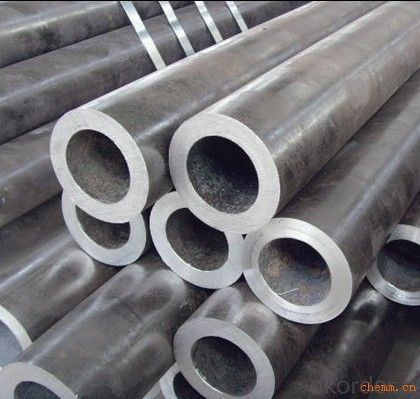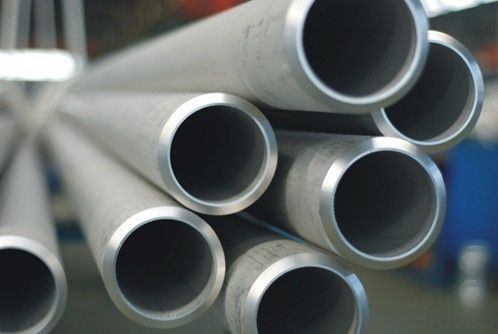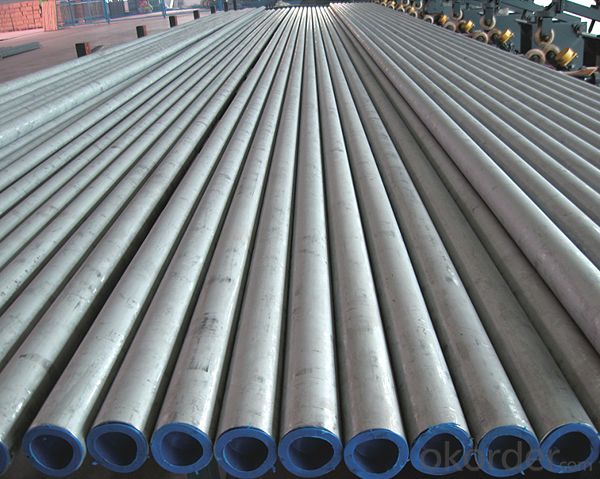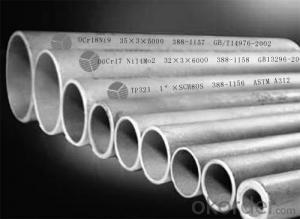Stainless Duplex Seamless Steel Pipe 31500
- Loading Port:
- Ningbo
- Payment Terms:
- TT OR LC
- Min Order Qty:
- 1 m.t.
- Supply Capability:
- 5000 m.t./month
OKorder Service Pledge
OKorder Financial Service
You Might Also Like
1、Structure of Stainless Duplex Seamless Steel Pipe 31500 Description:
Duplex Stainless steel pipe and tubing are used for a variety of reasons: to resist corrosion and oxidation, to resist high temperatures, for cleanliness and low maintenance costs, and to maintain the purity of materials which come In contact with stainless. The inherent characteristics of stainless steel permit the design of thin wall piping systems without fear of early failure due to corrosion.2、Main Features of the Duplex Seamless Steel Pipe 31500:
• High manufacturing accuracy
• High strength
• Small inertia resistance
• Strong heat dissipation ability
• Good visual effect
•Reasonable price
3、Duplex Seamless Steel Pipe 31500 Images:



4、Duplex Seamless Steel Pipe 31500 Specification:
Detail infomation
Standards: ASTM/ASME A789/SA789, A790/SA790,A450,A530
Material: UNS S31803(Cr22Ni5Mo3/1.4462)/2205,UNS S32750(1.4410),UNS S31500(Cr18NiMo3Si2),
UNS32760(1.4501)
Chemical Composition
Grade | C max | Si max | Mn max | P max | S max | Cr | Ni | Mo | N |
UNS S32750 | 0.030 | 0.8 | 1.2 | 0.030 | 0.015 | 24.0-26.0 | 6.0-8.0 | 3.0-5.0 | 0.24-0.32 |
UNS S31803 | 0.030 | 1.0 | 2.0 | 0.020 | 0.020 | 21.0-23.0 | 4.5-6.5 | 2.5-3.5 | 0.08-0.20 |
UNS S31500 | 0.030 | 1.0 | 1.2-2.0 | 0.030 | 0.030 | 18.0-19.0 | 4.5-5.5 | 2.5-3.5 | 0.05-0.10 |
Physical Properties
Grade | Y.S.MPa min | T.S.Mpa min | Elongation % | Hardness HRC |
UNS S32750 | 550 | 800 | 15 | 20 |
UNS S31803 | 450 | 620 | 25 | 20 |
UNS S31500 | 440 | 630 | 30 | 20 |
Supplementary Testing :
we also carry out on the manufactured products supplementary testing.
Radiography Testing |
Macro Testing |
Liquid Penetrate testing |
5、FAQ of Duplex Seamless Steel Pipe 31500:
①How is the quality of your products?
Our products are manufactured strictly according to national and internaional standard, and we take a test
on every pipe before delivered out. If you want see our quality certifications and all kinds of testing report, please just ask us for it.
Guaranteed: If products’ quality don’t accord to discription as we give or the promise before you place order, we promise 100% refund.
②How about price?
Yes, we are factory and be able to give you lowest price below market one, and we have a policy that “ for saving time and absolutely honest business attitude, we quote as lowest as possible for any customer, and discount can be given according to quantity”,if you like bargain and factory price is not low enough as you think, just don’t waste your time.Please trust the quotation we would give you, it is professional one.
③Why should you chose us?
Chose happens because of quality, then price, We can give you both.Additionally, we can also offer professional products inquiry, products knowledge train(for agents), smooth goods delivery, exellent customer solution proposals.Our service formula: good quality+good price+good service=customer’s trust
SGS test is available, customer inspection before shipping is welcome, third party inspection is no problem.
Any question, pls feel free to contact us !
- Q:Are stainless steel pipes resistant to crevice corrosion?
- Yes, stainless steel pipes are generally resistant to crevice corrosion. Due to their composition, which includes a significant amount of chromium, stainless steel pipes form a protective oxide layer that prevents the formation of crevices and minimizes the risk of crevice corrosion. However, the resistance to crevice corrosion may vary depending on the specific grade of stainless steel and the environmental conditions in which the pipes are used.
- Q:How are stainless steel pipes joined together?
- Stainless steel pipes are joined together through various methods such as welding, threading, and compression fittings.
- Q:Can stainless steel pipes be used for gas pipelines?
- Indeed, gas pipelines can utilize stainless steel pipes. Stainless steel, renowned for its exceptional durability and resistance to corrosion, proves to be an ideal material for transporting a wide range of gases, including natural gas and propane. Moreover, stainless steel pipes possess remarkable tensile strength, enabling them to endure the demanding conditions of high pressure and temperature frequently encountered in gas pipelines. Furthermore, stainless steel demonstrates non-reactivity, thereby guaranteeing the integrity and safety of the pipeline system by preventing any interaction with the transported gases. Ultimately, with its strength, corrosion resistance, and capability to withstand high-pressure environments, stainless steel pipes emerge as a dependable choice for gas pipelines.
- Q:What are stainless steel pipes?
- Stainless steel pipes are pipes made from a corrosion-resistant alloy known as stainless steel. They are commonly used in various industries such as construction, oil and gas, and plumbing due to their durability, strength, and resistance to rust and corrosion. Stainless steel pipes are known for their long lifespan, high temperature resistance, and ability to withstand harsh environmental conditions.
- Q:Can stainless steel pipes be insulated with polyphenylene sulfide?
- Yes, stainless steel pipes can be insulated with polyphenylene sulfide (PPS). PPS is a high-performance thermoplastic that offers excellent thermal and chemical resistance properties. It can be used as an insulation material for various applications, including pipes and tubing. When applied as insulation on stainless steel pipes, PPS can help in reducing heat transfer and preventing condensation. Additionally, PPS is also resistant to many chemicals, making it suitable for use in corrosive environments.
- Q:How do you calculate the bending radius of stainless steel pipes?
- To calculate the bending radius of stainless steel pipes, you need to consider several factors. The bending radius is determined by the diameter of the pipe, the wall thickness, and the type of stainless steel being used. First, you need to determine the outside diameter (OD) of the pipe. This can be measured directly or obtained from the pipe specifications. Next, you should identify the wall thickness of the pipe. This information is available in the pipe specifications or can be measured using a caliper. Once you have the OD and wall thickness, you can calculate the inside diameter (ID) of the pipe by subtracting twice the wall thickness from the OD. This is because the wall thickness is evenly distributed on both sides of the pipe. Now that you have the ID, you can calculate the bending radius. The bending radius is typically expressed as a multiple of the pipe's OD. The general rule is that the bending radius should be at least three times the OD for stainless steel pipes. However, this value may vary depending on the specific application and the type of stainless steel being used. It is important to note that bending stainless steel pipes beyond their recommended bending radius can lead to deformation, cracking, or failure. Therefore, it is crucial to follow the manufacturer's guidelines and consult with an engineer or a professional experienced in working with stainless steel pipes for accurate calculations.
- Q:Can stainless steel pipes be used for brewery and beverage industry applications?
- Stainless steel pipes are suitable for use in brewery and beverage industry applications. This material is renowned for its exceptional corrosion resistance and hygienic properties, making it an ideal option for these sectors. The presence of high levels of chromium and nickel in stainless steel pipes provides excellent protection against corrosion caused by chemicals, acids, and high temperatures. Moreover, stainless steel pipes are easy to clean and maintain, ensuring the highest level of hygiene required in brewery and beverage production. The smooth inner surface of these pipes also reduces the risk of contamination and bacterial growth, making them even more suitable for these applications. In summary, stainless steel pipes offer durability, reliability, and sanitary features that make them the preferred choice for the brewery and beverage industry.
- Q:What are the categories of stainless steel pipes with acid and alkali resistance?
- Stainless steel is usually classified according to the organization of the matrix, as follows:The ferritic stainless steel (200 and 400) the chromium content in 15%~30%, with a body centered cubic crystal structure. This kind of steel does not contain nickel, sometimes also contain a small amount of Mo, Ti, Nb and other elements, this kind of steel has high heat conductivity, low expansion coefficient, good oxidation resistance and anti stress excellent characteristics of stress corrosion, used formanufacturingthecorrosionresistanceofthe atmosphere, water vapor, waterandoxidizing parts. Ferritic stainless steel prices are relatively low and stable, and has many unique characteristics and advantages, it has been proved that in many of the original that can only use austenitic stainless steel (300) application of ferritic stainless steel is a very excellent substitute materials, ferritic stainless steel containing nickel, the main elements of Cr (>10%) and iron, chromium stainless steel special corrosion resistant elements, its price is relatively stable.. Chromium 12% ~ 30%. Its corrosion resistance and toughness increase with the increase of chromium content, and the weldability is excellent.
- Q:Can stainless steel pipes be used for sewage treatment plants?
- Yes, stainless steel pipes can be used for sewage treatment plants. Stainless steel offers exceptional resistance to corrosion, making it an ideal choice for handling wastewater and other corrosive substances commonly found in sewage treatment plants. Additionally, stainless steel pipes are durable, hygienic, and easy to maintain, making them suitable for the demanding conditions of sewage treatment facilities.
- Q:How do you prevent leaks in stainless steel pipes?
- To prevent leaks in stainless steel pipes, there are various measures that can be taken: 1. Ensuring proper installation: It is crucial to correctly install stainless steel pipes, which involves using suitable fittings and connectors, securely fastening the pipes, and following the installation guidelines provided by the manufacturer. 2. Regular inspection and maintenance: Regularly inspecting stainless steel pipes can help identify any signs of wear, corrosion, or damage that may potentially result in leaks. This can be done through visual inspection or by utilizing non-destructive testing methods like ultrasonic testing. 3. Implementing corrosion prevention measures: While stainless steel pipes are known for their corrosion resistance, certain conditions can still lead to corrosion and potential leaks. The risk can be significantly reduced by implementing corrosion prevention measures such as using corrosion-resistant coatings, cathodic protection systems, or inhibitors. 4. Proper cleaning and maintenance: Regularly cleaning and maintaining stainless steel pipes can help eliminate accumulated debris, dirt, or chemicals that may cause corrosion or damage. This can be achieved by using appropriate cleaning agents and techniques recommended by the manufacturer. 5. Conducting pressure testing: Performing pressure tests on stainless steel pipes is an effective way to identify any weak points or potential leaks. This involves applying pressure to the pipes and monitoring for any pressure drop, which could indicate a leak. Pressure testing should be carried out during installation and periodically thereafter. 6. Controlling temperature: Extreme temperatures can cause thermal expansion or contraction of stainless steel pipes, which may lead to leaks. To prevent this, proper insulation, installation of expansion joints, or utilization of flexible connectors can be employed to accommodate these temperature changes. 7. Regular monitoring and repair: It is crucial to establish a system for regularly monitoring stainless steel pipes for any signs of leaks or damage. This can include periodic inspections, leak detection systems, or remote monitoring technologies. Promptly repairing any identified issues can prevent further damage and potential leaks. By adhering to these preventive measures, the risk of leaks in stainless steel pipes can be significantly minimized, ensuring their durability and preserving the integrity of the system they are a part of.
1. Manufacturer Overview |
|
|---|---|
| Location | |
| Year Established | |
| Annual Output Value | |
| Main Markets | |
| Company Certifications | |
2. Manufacturer Certificates |
|
|---|---|
| a) Certification Name | |
| Range | |
| Reference | |
| Validity Period | |
3. Manufacturer Capability |
|
|---|---|
| a)Trade Capacity | |
| Nearest Port | |
| Export Percentage | |
| No.of Employees in Trade Department | |
| Language Spoken: | |
| b)Factory Information | |
| Factory Size: | |
| No. of Production Lines | |
| Contract Manufacturing | |
| Product Price Range | |
Send your message to us
Stainless Duplex Seamless Steel Pipe 31500
- Loading Port:
- Ningbo
- Payment Terms:
- TT OR LC
- Min Order Qty:
- 1 m.t.
- Supply Capability:
- 5000 m.t./month
OKorder Service Pledge
OKorder Financial Service
Similar products
New products
Hot products
Hot Searches
Related keywords





























